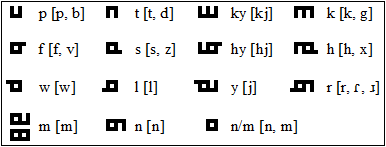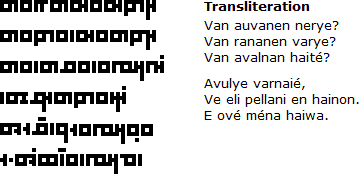The Kain are a phonetic alphabet/abjad used to represent the constructed language Kyetta. The script and conlang were invented by outofgloom.


-As can be seen, there is no explicit distinction of voice amongst consonants in the script. This is because the original language from which Kyetta descended (and for which the primitive form of the kain were created) did not distinguish between voiced and voiceless phonemes (at least in most stops and fricatives).
-Regarding the nasal glyphs in the bottom row, the two separate /m/ and /n/ glyphs were originally ligatures. However, their usage was always infrequent, since the basic nasal glyph (third from the left) could be used to represent either phoneme. The labial glyph was nevertheless used in a more frequent degree than the dental, but was many times supplanted by a modified form of the basic nasal (shown beneath the /m/ glyph).
-Vowel glyphs are frequently absorbed into the consonants which precede them.
Thus /s/ ![]() would take the vowel /a/ as
would take the vowel /a/ as ![]() , etc.
, etc.

-Certain aspects of the consonant glyphs are variable depending on the
placement of the glyphs in a word. For example, the extending horizontal
line in some glyphs could be altered so that it extended below the line
of writing. Thus, the glyphs for /l/ and /r/ had alternate forms
![]() and
and ![]() ,
respectively, when they were in a medial position, while the glyph for
/h/ could also be written
,
respectively, when they were in a medial position, while the glyph for
/h/ could also be written ![]() .
This was primarily a space-saving convention.
.
This was primarily a space-saving convention.
-As of now, there is no system of punctuation. Word boundaries are frequently apparent from the form of the vowel used (ex: whether or not a vowel is absorbed into the preceding consonant could indicate if it is a part of the preceding word).
-The palatal series can be used to represent the palatal affricates, if necessary. Otherwise a horizontal line can be used above or below the dental series of glyphs (see sample English text below).
-Aesthetically, writing English in a more phonetic style is more preferable to simply imitating English orthography and spelling conventions, since the script was not necessarily invented with English in mind.

All human beings are born free and equal in dignity and rights. They
are endowed with reason and conscience and should act towards one another
in a spirit of brotherhood.
(Article 1 of the Universal Declaration of Human Rights)

If you have any questions about this alphabet, you can contact outofgloom at: outofgloom@gmail.com
Download a font for The Kain (created by Bryson Schnaitmann)
Constructed scripts for: Ainu | Arabic | Chinese languages | Dutch | English | Hawaiian | Hungarian | Japanese | Korean | Lingala | Malay & Indonesian | Persian | Tagalog / Filipino | Russian | Sanskrit | Spanish | Taino | Turkish | Vietnamese | Welsh | Other natural languages | Colour-based scripts | Tactile scripts | Phonetic/universal scripts | Constructed scripts for constructed languages | Adaptations of existing alphabets | Fictional alphabets | Magical alphabets | A-Z index | How to submit a constructed script
[top]
You can support this site by Buying Me A Coffee, and if you like what you see on this page, you can use the buttons below to share it with people you know.

If you like this site and find it useful, you can support it by making a donation via PayPal or Patreon, or by contributing in other ways. Omniglot is how I make my living.
Note: all links on this site to Amazon.com, Amazon.co.uk
and Amazon.fr
are affiliate links. This means I earn a commission if you click on any of them and buy something. So by clicking on these links you can help to support this site.
[top]